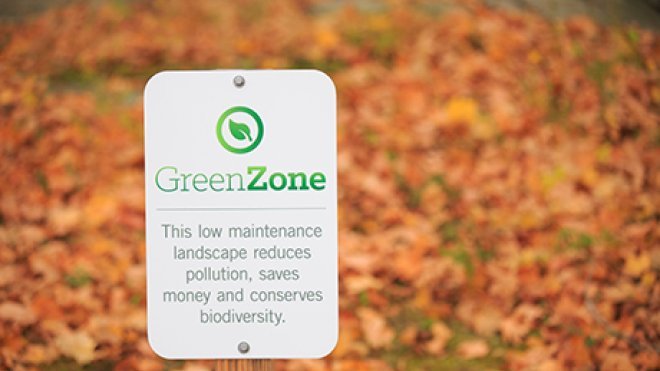Green Zones Grow on Campus Grounds
Environmentally responsible landscaping practices take root at RWU

BRISTOL, R.I. – To the untrained eye, it doesn’t appear too different from the traditionally landscaped grounds of Roger Williams University, but natural terrain has been sprouting across campus for two years in an effort to implement more environmentally sustainable landscaping practices.
Established as “Green Zones” by the University's Sustainable Grounds Committee – a group of faculty and staff who proposed the idea and identified areas on campus to establish low-maintenance areas – these selected regions are being permitted to grow naturally, subject to Mother Nature’s elements, with only a few grass trimmings now and then. These parts of campus are not watered or fertilized, nor will dead patches be reseeded or replaced with fresh green sod.
The concept isn’t new to the landscaping industry, according to Grounds Supervisor Matt Clement, noting that the Facilities staff has enacted a number of sustainable practices in recent years to reduce the campus’s environmental footprint. The Green Zones are a more visible part of a much broader campus plan, thanks in part to signs demarcating these areas. The practice has been growing among institutions and businesses with substantial landscaped grounds, he says – universities and golf courses, for example.
“Everybody wants to do their part to be more environmentally sustainable, and Roger Williams strives to implement sustainable practices wherever possible,” Clement says. “To reduce some of the environmental and economic impact of the regularly landscaped parts of campus, the committee selected sections that will become natural growth areas.”
That means clover, dandelions and other wildflowers will take root and the grass will grow a little taller – and don’t be surprised if some patches in these areas begin to brown in the sweltering drought of late summer.
The first Green Zones popped up in spring 2014: the grounds surrounding the Marine and Natural Sciences building; the rocky outcropping between the Fine Arts Center and Center for Student Development; behind Bayside; and the hillside between the Cedar and Willow halls. This past spring saw the addition of Green Zones near the parking garage, the Performing Arts Annex, the water tower, the turf field and Stonewall Hall.
In total more than 6 acres of the campus are now au naturel – a measure that will minimize the environmental impact of landscaping, save the University money in materials and labor, and promote biodiversity by allowing life to naturally flourish.